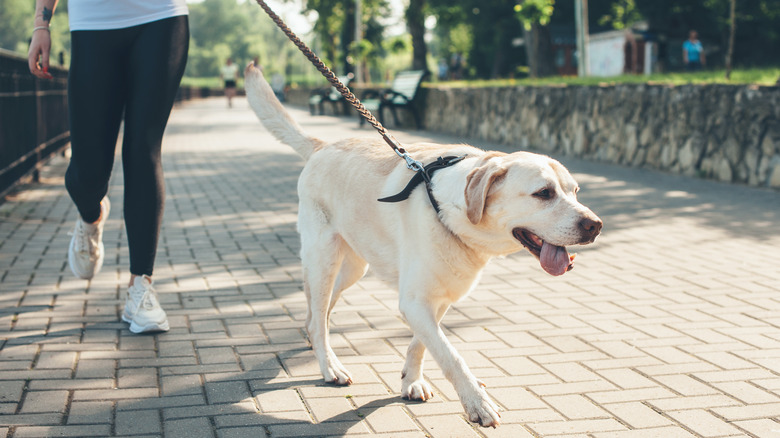What Happens To Your Body When You Walk Your Dog Every Day
Owning a dog comes with a lot of responsibility. You need to feed them, stay up to date on vet appointments, and teach them how to behave well. Dogs also need plenty of exercise, which means you need to walk them at least once a day to keep them healthy. But walking your dog isn't just good for your pet — it also gets you outside and moving every day.
According to a study published in BMC Public Health, people who own dogs walk an average of 22 minutes more per day than those who don't have a furry friend at home (via NPR). The study also found that people tend to move at a moderate pace when walking their dog, as opposed to a leisurely stroll.
Walking is an excellent form of exercise. Many experts agree it's one of the most underrated exercises because it takes little effort yet offers many health benefits. According to John Ford, a certified exercise physiologist who runs JKF Fitness & Health in New York City, "walking is a really good form of exercise and can help you reach your fitness and weight-loss goals" (via NBC News). While Ford agrees there are other forms of exercise that offer faster physical results than walking, this simple exercise is a great option for all levels of fitness.
Walks should focus on your dog but can still be a workout for you
It's clear that walking offers plenty of health benefits, but you shouldn't approach walking your dog as an intense form of exercise for yourself. According to the American Kennel Club, walks offer mental stimulation as well as physical exercise for pets. Dogs have an incredible sense of smell and enjoying sniffing their surroundings as they move around. The AKC states that "dragging your dog away from an interesting scent, or asking him to heel the entire way around the block, prevents him from truly taking in everything around him and diminishes the mental stimulation a walk can provide."
Although walking your dog is a great form of physical activity, you should be prepared for a lot of stop-and-go action when you take your pup out. This means you probably shouldn't rely on walks with your dog as your only form of exercise. Some walks may have you moving briskly for a solid 45 minutes while others may be your dog mostly sniffing the sidewalk as you inch along with them. The CDC recommends that adults get 150 minutes of moderate-intensity physical activity per week (via Centers for Disease Control and Prevention). Depending on how your dog prefers to lead their walks, you may need to supplement them with other forms of exercise.


